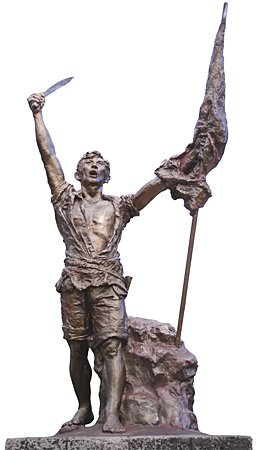Cultural Center of the Philippines
ENCYCLOPEDIA OF
PHILIPPINE ART
[Balintawak Monument] Homenaje Del Pueblo Filipino a Los Heroes Del ’96 / Alaala ng Bayaning Pilipino sa mga Bayani ng ’96 / Monumento sa mga Bayani ng 1896
(Tribute of the Filipino People to the Heroes of ’96 or Monument to the Heroes of 1896) / 1911 / Reinforced concrete / Life-size / Artist: Ramon Lazaro Martinez / Vinzons Hall, University of the Philippines Diliman
Alaala ng Bayang Pilipino sa mga Bayani ng ’96 or Monumento sa mga Bayani ng 1896 is a statue of a standing male figure with upraised arms holding a bolo in his right hand and a flag on his left. It was designed by Ramon Martinez (ca 1860-1950) and inaugurated on 3 Sep 1911 in Balintawak, which from 1908 to 1963 was officially the site of the country’s Cry of Rebellion against Spanish colonizers. According to Dominador Castañeda (1964), the statue is the first full-figure monument in reinforced concrete done in the Philippines. Martinez had been a faculty member of the Escuela Nacional de Pintura, Escultura y Grabado (National School of Painting, Sculpture and Engraving) in 1892 and this work’s idealized historical subject was consistent with his academic style.
Even though the monument is formally dedicated to the heroes of 1896, the lone figure is traditionally associated with Andres Bonifacio; hence, the work is popularly referred to as a Bonifacio monument. Together with the detail of Bonifacio’s image in the 1964 mural Filipino Struggles through History by Carlos V. Francisco, originally at the Manila City Hall, Martinez’s Monumento sa mga Bayani ng 1896 is an archetype of the romantic representation of a bolo-wielding, bare-chested, bare-footed Bonifacio in an open camisa de chino (Chinese shirt) and rolled up kundiman pants. While there are no physical markings on the flag, it is generally assumed that it represents the Katipunan flag because of the subject matter’s reference to the heroes of 1896 and Bonifacio himself. The Balintawak Monument was subsequently reproduced in the reverse of the 20-peso banknote issued by the Central Bank of the Philippines from 1951 to 1969. Its design has since been appropriated by numerous Bonifacio monuments in the Philippines.
The monument was originally erected in Balintawak at what is now the intersection of EDSA and Andres Bonifacio Ave / North Diversion Road in Quezon City. At that time, Balintawak was under the jurisdiction of the municipality of Caloocan. The Cry of Balintawak then was celebrated every 26 Aug to commemorate the start of the Philippine Revolution when Katipuneros (Filipino revolutionaries against Spain) symbolically tore their cedulas (tax certificates). In 1963, President Diosdado P. Macapagal shifted the official commemorations to Pugad Lawin in Quezon City every 23 Aug and renamed the event as the Cry of Pugadlawin. Presently, National Heroes Day, which marks the 1896 Cry, is celebrated every last Monday of August. During the construction of the North Diversion Road, the monument was transferred to Vinzons Hall at the University of the Philippines in Diliman, Quezon City. It was installed on 19 Nov 1968. A bronze replica now stands in Balintawak.
Written by Roberto Eliseo G. Paulino
Sources
Castañeda, Dominador. 1964. Art in the Philippines. Quezon City: Office of Research Coordination, University of the Philippines.
Guerrero, Milagros C., Emmanuel N. Encarnacion, and Ramon N. Villegas. 1996. “Balintawak: The Cry for a Nationwide Revolution.” Sulyap Kultura, 2, 13-21. Manila: National Commission for Culture and the Arts.
Ocampo, Ambeth R. 1995. “Bonifacio: Myth and Reality.” In Bonifacio’s Bolo, 5-9. Pasig City: Anvil Publishing Inc.
Philippine Collegian. 1968a. “Bonifacio Monument Inauguration Slated.” 20 Nov, pp. 1, 7.
———. 1968b. “The Cry of Balintawak.” 4 Dec, p. 1.
Presidential Museum and Library. 2012. “Imprinting Andres Bonifacio: The Iconization from Portrait to Peso.” 29 Nov. Accessed 30 Dec 2013. http://malacanang.gov.ph/2942-
imprinting-andres-bonifacio-the- iconization-from-portraitto-peso/.
Renacimiento Filipino. 1911a. Cover. 14 Jul.
———. 1911b. Cover and pp. 323-33. 14 Sep.
Santiago, Luciano P. R. 1989. “Philippine Academic Art: The Second Phase (1845-1898).” Philippine Quarterly of Culture and Society 17:67-89.
